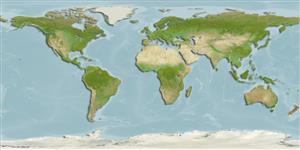>
Gobiesociformes (Clingfishes) >
Gobiesocidae (Clingfishes and singleslits) > Diplocrepinae
Etymology: Diplocrepis: Greek, diploos = twice + Greek, krepis, idos = base, foundation (Ref. 45335).
More on author: Richardson.
Environment: milieu / climate zone / depth range / distribution range
Ökologie
seewasser demersal; tiefenbereich 0 - 15 m (Ref. 9003). Temperate
Southwest Pacific: endemic to New Zealand.
Size / Gewicht / Alter
Maturity: Lm ? range ? - ? cm
Max length : 12.5 cm SL Männchen/unbestimmt; (Ref. 9003); common length : 8.5 cm SL Männchen/unbestimmt; (Ref. 9003)
Kurzbeschreibung
Morphologie | Morphometrie
Rückenflossenstacheln (insgesamt): 0; Rückenflossenweichstrahlen (insgesamt): 10-11; Afterflossenstacheln 0; Afterflossenweichstrahlen: 4 - 5. Olive pink or green to brown, red, yellow or lilac, with or without stripes, spots or bars. Breeding males with pinkish dorsal saddle. Distinguished from other clingfishes by the large, rounded head with incisorform teeth and a large, blunt posteriorly projecting spine at the lower margin of the operculum.
Common in rock pools at low tide and sub-tidally. Found clinging under rocks or boulders in more sheltered areas. Feeds on amphipods, gastropods, and fishes. Takes cover when disturbed.
Eggs are guarded by the male.
Paulin, C. and C. Roberts, 1992. The rockpool fishes of New Zealand (Te ika aaria o Aotearoa). Museum of New Zealand (Te Papa Tongarewa). 177 p. (Ref. 9003)
IUCN Rote Liste Status (Ref. 130435)
Bedrohung für Menschen
Harmless
Nutzung durch Menschen
Mehr Information
Alter/GrößeWachstumLänge-GewichtLänge-LängeLängenhäufigkeitenMorphometrieMorphologieLarvenLarven Pop.Dyn.RekrutierungDichteBRUVS
ReferenzenAquakulturAquakultur ProfilZuchtlinienGenetikElectrophoresesVererbbarkeitKrankheitenVerarbeitungNutrientsMass conversion
PartnerBilderStamps, Coins Misc.LauteCiguateraGeschwindigkeitSchwimmstilKiemenoberflächeOtolithsGehirngrößeSehfähigkeit
Tools
Zusatzinformationen
Download XML
Internet Quellen
Estimates based on models
Preferred temperature (Ref.
123201): 12 - 16.5, mean 14.8 °C (based on 80 cells).
Phylogenetic diversity index (Ref.
82804): PD
50 = 1.0000 [Uniqueness, from 0.5 = low to 2.0 = high].
Bayesian length-weight: a=0.00468 (0.00180 - 0.01218), b=3.12 (2.90 - 3.34), in cm total length, based on LWR estimates for this (Sub)family-body shape (Ref.
93245).
Trophic level (Ref.
69278): 3.7 ±0.63 se; based on food items.
Widerstandsfähigkeit (Ref.
120179): mittel, Verdopplung der Population dauert 1,4 - 4,4 Jahre. (Fec = 2,500).
Fishing Vulnerability (Ref.
59153): Low vulnerability (10 of 100).
